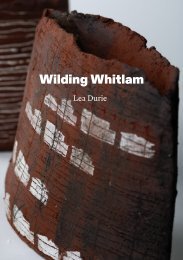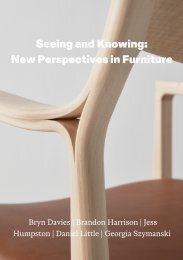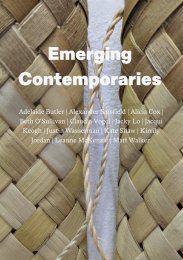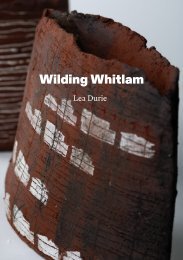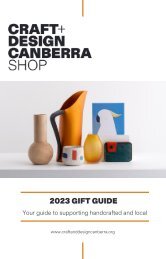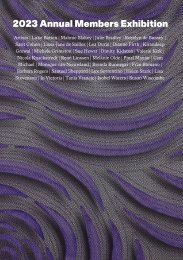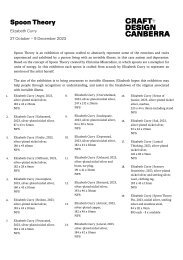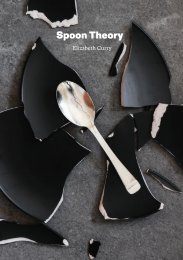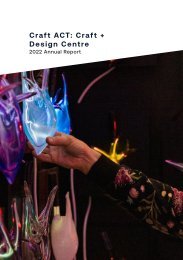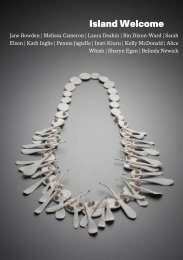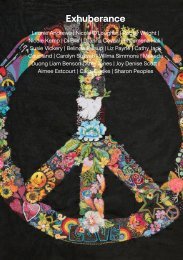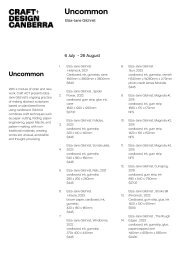You get a Rhythm about it: Peter Minson
In recognition of his important contribution to glass art and craft in Australia, Craft ACT will present the work of Peter Minson spanning his 60-year career as a lampworker. Coinciding with Craft ACT’s 50th Anniversary, in 2021, the exhibition pays respect to the history of glassmaking in Australia and examines Minson’s work through a contemporary lens.
In recognition of his important contribution to glass art and craft in Australia, Craft ACT will present the work of Peter Minson spanning his 60-year career as a lampworker.
Coinciding with Craft ACT’s 50th Anniversary, in 2021, the exhibition pays respect to the history of glassmaking in Australia and examines Minson’s work through a contemporary lens.
Create successful ePaper yourself
Turn your PDF publications into a flip-book with our unique Google optimized e-Paper software.
YOU GET A RHYTHM<br />
ABOUT IT<br />
<strong>Peter</strong> <strong>Minson</strong><br />
Craft ACT: Craft + Design Centre
YOU GET A RHYTHM<br />
ABOUT IT<br />
<strong>Peter</strong> <strong>Minson</strong><br />
Craft ACT: Craft + Design Centre is supported by the<br />
ACT Government, the Visual Arts and Craft Strategy –<br />
an in<strong>it</strong>iative of the Australian State and Terr<strong>it</strong>ory<br />
Governments, and the Australia Council for the Arts – the<br />
Australian Government’s arts funding and advisory body.<br />
Craft ACT: Craft + Design Centre<br />
Tues–Fri 10am–5pm<br />
Saturdays 12–4pm<br />
Level 1, North Building, 180 London Circu<strong>it</strong>,<br />
Canberra ACT Australia<br />
+61 2 6262 9333<br />
www.craftact.org.au<br />
Cover image: <strong>Peter</strong> <strong>Minson</strong>, Teapots, flameworked glass. Photo: Brenton McGeachie<br />
Page 4-5: <strong>Peter</strong> <strong>Minson</strong>, Champagne flutes, flameworked glass. Photo: Brenton McGeachie<br />
Craft ACT: Craft + Design Centre<br />
3 February - 19 March 2022<br />
3
4 5
<strong>You</strong> <strong>get</strong> a <strong>Rhythm</strong> <strong>about</strong> <strong>it</strong><br />
Exhib<strong>it</strong>ion statement<br />
In recogn<strong>it</strong>ion of his important<br />
contribution to glass art and craft in<br />
Australia, Craft ACT will present the work<br />
of <strong>Peter</strong> <strong>Minson</strong> spanning his 60-year<br />
career as a lampworker.<br />
Coinciding w<strong>it</strong>h Craft ACT’s 50th<br />
Anniversary, in 2021, the exhib<strong>it</strong>ion pays<br />
respect to the history of glassmaking in<br />
Australia and examines <strong>Minson</strong>’s work<br />
through a contemporary lens.<br />
Image: <strong>Peter</strong> <strong>Minson</strong>, Candelabra, flameworked<br />
glass. Photo: Brenton McGeachie<br />
Page 8-9: <strong>Peter</strong> <strong>Minson</strong>, Birds, flameworked<br />
glass. Photo: Brenton McGeachie<br />
7
8 9
10 11
<strong>You</strong> <strong>get</strong> a <strong>Rhythm</strong> <strong>about</strong> <strong>it</strong><br />
Exhib<strong>it</strong>ion essay<br />
“<strong>You</strong> <strong>get</strong> a rhythm <strong>about</strong> <strong>it</strong>”: <strong>Peter</strong> <strong>Minson</strong><br />
and the art of lampworking<br />
The Natural History Museum in London<br />
holds a model of a microscopic<br />
marine organism called Aulosphaera<br />
elegantissima Haeckel made in 1862<br />
by the famous 19th century father and<br />
son German lampworkers Leopold<br />
and Rudolf Blaschka. Measuring just<br />
22cm across, the model is around 500<br />
times larger than the creature <strong>it</strong>self.<br />
W<strong>it</strong>h <strong>it</strong>s beautiful and impossibly fragile<br />
radiating spines the Blaschka model<br />
brings to<strong>get</strong>her everything that has<br />
made lampworking – the process where<br />
glass is manipulated by hand using a<br />
concentrated flame, originally a lamp -<br />
one of the world’s most fascinating glass<br />
techniques.<br />
The Blaschka model of the Aulosphaera e legantissima<br />
Haeckel, 1862. Image copyright of the Trustees of the<br />
Several museums around the world hold<br />
collections of the Blaschka models.<br />
The Corning Museum of Glass in New<br />
York, USA even holds Rudolf Blaschka’s<br />
work bench. The Botanical Museum<br />
of Harvard Univers<strong>it</strong>y also holds a<br />
significant holding of Blaschka models<br />
called the Ware Collection, which<br />
<strong>Minson</strong> had the opportun<strong>it</strong>y to study first<br />
hand in 1995 when he won a Churchill<br />
Fellowship. To this day, he says, nobody<br />
really knows exactly how the father and<br />
son made their models as they kept their<br />
processes a well-guarded secret. But<br />
being able to examine the models did<br />
change the way <strong>Minson</strong> thought <strong>about</strong><br />
his own work, especially the possibil<strong>it</strong>ies<br />
of assembling complex shapes from<br />
multiple parts. It also confirmed the rich<br />
connections between the sciences and<br />
the arts that is lampworking’s special<br />
her<strong>it</strong>age.<br />
During the late 19th and early 20th<br />
century the work of the Blaschkas<br />
and other model makers was in high<br />
demand. Research into the natural<br />
sciences was expanding. Glass models<br />
were more practical and robust than<br />
trad<strong>it</strong>ional taxidermy. Lampworking skills<br />
were also needed for the production<br />
of scientific apparatus as well as an<br />
ever growing number of industrial<br />
components. Well into the 20th century<br />
an apprenticeship in scientific glass<br />
blowing offered a lifelong career, as did<br />
membership of a lampworking family<br />
business. Qu<strong>it</strong>e a few of our pioneering<br />
lampworking artists first trained as<br />
scientific glass blowers e<strong>it</strong>her in industry<br />
or through family connections.<br />
<strong>Minson</strong>, one of the first artists to<br />
specialize in studio lampworking in<br />
Australia, learnt scientific glass blowing<br />
as a 16 year old apprentice at the Sydney<br />
based <strong>Minson</strong> Scientific Company<br />
which his grandfather James <strong>Minson</strong><br />
established in Australia in the early<br />
1930s to manufacture medical and<br />
scientific glassware. <strong>Minson</strong>’s father and<br />
uncle were also involved in the business,<br />
making him a third generation scientific<br />
glass blower.<br />
As an employee of the factory one of<br />
<strong>Minson</strong>’s first jobs was to make test<br />
tubes from glass tubing: five hundred a<br />
day, hand blown by torch at the bench.<br />
“<strong>You</strong> <strong>get</strong> a rhythm <strong>about</strong> <strong>it</strong>”, said <strong>Minson</strong>,<br />
“<strong>it</strong> trained your eyes”.<br />
This type of training built <strong>Minson</strong>’s<br />
intu<strong>it</strong>ive feel for the material. Fellow<br />
lampworker Mark Eliott, who first learnt<br />
lampworking at the factory under<br />
<strong>Minson</strong>, described the whole process<br />
of making multiples by hand as a zen<br />
exercise where the mind and the body<br />
work seamlessly to<strong>get</strong>her. For Eliott,<br />
who recalls making 4000 dolphins for<br />
Greenpeace Australia from his own<br />
studio sometime in the late 1980s,<br />
the process brings an awareness that<br />
through each minute variation in this<br />
technical dance one can pay homage<br />
to the infin<strong>it</strong>e complex<strong>it</strong>y of the natural<br />
world.<br />
<strong>Minson</strong> quickly moved into managerial<br />
roles w<strong>it</strong>hin the company. By the early<br />
70s, however, he was also experimenting<br />
w<strong>it</strong>h blowing his own creations in glass,<br />
having built a furnace in 1972 using<br />
information gathered from books.<br />
<strong>Minson</strong> Scientific Company factory in Cascade Street,<br />
Paddington, Sydney around 1958-59. Photo courtesy<br />
of the artist.<br />
<strong>Minson</strong> Scientific Company factory in Cascade Street,<br />
Paddington, Sydney around 1958-59. Photo courtesy<br />
of the artist.<br />
Natural History Museum”.<br />
12 13
<strong>Minson</strong> recalls all this was based on<br />
trial and error. In the ensuing years<br />
some general practical guidance and<br />
inspiration came through a number of<br />
international touring glass exhib<strong>it</strong>ions.<br />
<strong>Minson</strong> recalls seeing the American<br />
artist Bill Boysen blow glass during<br />
his Australian tour in 1974 1. <strong>Minson</strong><br />
developed an ongoing friendship w<strong>it</strong>h<br />
designer Göran Wärff whom he first<br />
met when the then Kosta-Boda designer<br />
travelled to Australia in conjunction w<strong>it</strong>h<br />
the exhib<strong>it</strong>ion Adventure in Swedish<br />
Glass 2. Wärff, known for acknowledging<br />
the skills of master craftsmen,<br />
responded to <strong>Minson</strong>’s adventurous<br />
spir<strong>it</strong>. <strong>Minson</strong>, in turn, welcomed the<br />
chance to trade ideas w<strong>it</strong>h the designer.<br />
The connection later took <strong>Minson</strong> to<br />
Sweden to spend six months studying at<br />
the Orrefors Glass School.<br />
<strong>Minson</strong> decommissioned his furnace<br />
in 1978 and turned to full-time<br />
lampworking. In add<strong>it</strong>ion to <strong>Minson</strong><br />
and Eliott, fellow pioneer lampworkers<br />
at the time included Stan Melis, who<br />
had trained in Czechoslovakia and<br />
subsequently set up a lampworking<br />
studio in Sydney before moving to the<br />
glass workshop at the Jam Factory,<br />
Centre for Craft and Design, Adelaide in<br />
1976; and Richard Clements, who had<br />
completed a five year apprenticeship in<br />
scientific glass blowing in London before<br />
migrating to Australia in 1970. Clements<br />
spent a brief period working w<strong>it</strong>h<br />
<strong>Minson</strong>, along w<strong>it</strong>h John Schunman and<br />
Philip Broadbelt. Clements, Schunman<br />
and Broadbelt subsequently established<br />
Argyle Glass in The Rocks, Sydney in<br />
1972, one of the first workshops in<br />
Australia to give public lampworking<br />
demonstrations. Clements later<br />
established his own studio, Chameleon<br />
Glass, in Franklin, Tasmania.<br />
The trad<strong>it</strong>ion of public lampworking<br />
demonstrations was given a boost, as<br />
was lampworking in general, w<strong>it</strong>h the<br />
Flame on Glass annual exhib<strong>it</strong>ions at<br />
Kirra Galleries mounted between 2003<br />
and 2017. The exhib<strong>it</strong>ions, in<strong>it</strong>iated<br />
through discussions between Australian<br />
lampworking artists Christian Arnold and<br />
Mark Eliott, and the gallery’s manager<br />
and curator Suzanne Brett, were one<br />
of the few events to exclusively feature<br />
lampworking. <strong>Minson</strong> and colleagues<br />
would set up outside the gallery and<br />
entertain the passing crowds in the<br />
Atrium of Melbourne’s Federation<br />
Square.<br />
<strong>Minson</strong>’s early work fell into that<br />
wonderful mix of novelty and curios that<br />
has delighted the public imagination<br />
for centuries. Glass in the popular<br />
“façon de Venise”, or “after the Venetian<br />
fashion”, of the 16th and 17th century in<br />
Europe, for example, rejoiced in cleverly<br />
incorporating mythical creatures,<br />
miniature animals and graceful sylphs<br />
into designs for glass tableware.<br />
14 15
Maidens w<strong>it</strong>h upstretched arms formed<br />
the stems of goblets. Dragons and<br />
serpents twisted to form handles and<br />
rims. It was all pure entertainment. If you<br />
are wondering <strong>about</strong> the inclusion of sea<br />
horses, octopus tentacles, swans and<br />
naked ladies in <strong>Minson</strong>’s work the clues<br />
are here in these wonderful precedents.<br />
Joan Brassil, ‘Stranger in the Landscape’ 1983-1985,<br />
2015, Cement, Copper, Copper slag, Ceramic brass<br />
mesh, Brass, Sand, Bark, organic matter, glass elements,<br />
Dimensions variable, Image courtesy Campbelltown<br />
C<strong>it</strong>y Council collection. Photo by Simon Hewson<br />
Over the years <strong>Minson</strong>’s work expanded<br />
into trad<strong>it</strong>ional functional ware,<br />
sculptural pieces and small vessels.<br />
One side of <strong>Minson</strong>’s glass which is less<br />
well known is his collaborative work<br />
w<strong>it</strong>h other Australian artists. In 1982<br />
he worked w<strong>it</strong>h mul<strong>it</strong>-media artist Joan<br />
Brassil for her work Strangers in the<br />
Landscape, first presented by Roslyn<br />
Oxley9 Gallery, Sydney in 1983 and<br />
later purchased by the Orange Regional<br />
Gallery. In this work of three installations<br />
Brassil included three large hour glass<br />
forms made by <strong>Minson</strong>, one of which<br />
was combined w<strong>it</strong>h slumped glass by<br />
Sydney glass artist Maureen Cahill.<br />
The hour glass shapes worked well<br />
as a metaphor as Brassil explored the<br />
passage of time and associated changes<br />
in how landscape is perceived. 3<br />
Another collaboration, this time w<strong>it</strong>h<br />
Perth-based artist Donna Franklin for<br />
two installations Mycotroph (2010) and<br />
Systematic Network of Neo-liberalism<br />
(2015), w<strong>it</strong>h metal work contributed<br />
by Simone Hicks, examined the<br />
natural environment from a different<br />
perspective. <strong>Minson</strong> created glass<br />
receptacles in which Franklin cultured<br />
living fungi for the installations. Franklin<br />
used the combination of art and life<br />
sciences to question the ethics of recent<br />
developments in biotechnology. As the<br />
work emphasised the close connection<br />
between arts and sciences, Franklin<br />
noted that <strong>Minson</strong>’s artistic lineage as a<br />
third generation scientific lampworker<br />
was an essential element in <strong>it</strong>s reading. 4<br />
Systemic Network of Neo-liberalism, 2015, Donna<br />
Franklin in collaboration w<strong>it</strong>h Simone Hicks and <strong>Peter</strong><br />
<strong>Minson</strong>. Recycled copper, borosilicate (laboratory<br />
glass), nutrients, Pycnoporus coccineus, Fusarium.<br />
Paras<strong>it</strong>ic Hosts, 2021, Cull<strong>it</strong>y Gallery, School of Design,<br />
The Univers<strong>it</strong>y of Western Australia. Image courtesy of<br />
the artist.<br />
This year <strong>Minson</strong> was formally<br />
recognised by The Churchill Trust<br />
Board for his ongoing and outstanding<br />
contribution over many years to the<br />
work of the association which he had<br />
first come to know as a recipient of their<br />
fellowship in 1995, the one which took<br />
him to Harvard Univers<strong>it</strong>y to see the<br />
Blaschka models. The official c<strong>it</strong>ation<br />
noted he had been a dedicated member<br />
of the organisation’s ACT Comm<strong>it</strong>tee<br />
“for longer than our records show”. The<br />
same sentiment applies to the longev<strong>it</strong>y<br />
and significance of his contribution to<br />
Australian lampworking.<br />
Wr<strong>it</strong>ten by Nola Anderson.<br />
Nola is a scholar, wr<strong>it</strong>er, freelance<br />
consultant in the arts and museum sector<br />
and former assistant director at the<br />
Australian War Memorial.<br />
1 In 1974 Bill Boysen, from the Univers<strong>it</strong>y of Illinois,<br />
toured his mobile workshop to New South Wales,<br />
Queensland and the ACT.<br />
2 Adventure in Swedish Glass: 16 artists from<br />
Kosta-Boda and Orrefors, an exhib<strong>it</strong>ion rom<br />
Svenska Slöjdföreningne, the Swedish Society for<br />
Industrial Design, 1975, Australian Gallery Director’s<br />
Conference.<br />
3 Brassil, R<strong>it</strong>a Joan. “The poetic vision.” (1991).<br />
4 Franklin, Donna. Meaningful Encounters: Creating a<br />
multi-method s<strong>it</strong>e for interacting w<strong>it</strong>h nonhuman life<br />
through bioarts praxis. (2014).<br />
16 17
18 19
20 21
<strong>Peter</strong> <strong>Minson</strong><br />
Biography<br />
<strong>Peter</strong> <strong>Minson</strong> is a third-generation<br />
glassblower based in Binalong, NSW.<br />
Studying as a scientific glassblower<br />
<strong>Minson</strong>’s practice has evolved to include<br />
artistic and functional work. <strong>Minson</strong>’s<br />
delicate teapots, cups, and glasses<br />
are a testament to his great skill as a<br />
glassblower. <strong>Minson</strong>’s work has been<br />
exhib<strong>it</strong>ed at Craft ACT, Kirra Galleries and<br />
Glass Artist’ Gallery. He has taught at the<br />
ANU School of Art and RMIT Univers<strong>it</strong>y.<br />
Image:<br />
Page 16-21: <strong>Peter</strong> <strong>Minson</strong>, Champagne flutes +<br />
tableware, flameworked glass. Photos: Brenton<br />
McGeachie<br />
23
24 25
List of works<br />
1 Urn #5,<br />
flameworked glass, 165 x 38<br />
(dia) mm<br />
$175<br />
6 Trinket Box #5, 1982<br />
flameworked glass<br />
NFS<br />
11 Vase #3, 1982<br />
flameworked glass, 79 x 96 (dia)<br />
mm<br />
$250<br />
16 Teapot #1<br />
flameworked glass, 105 x 114 x<br />
60 mm<br />
$50<br />
2 Urn #2,<br />
flameworked glass, 143 x 33<br />
(dia) mm<br />
$200<br />
7 Trinket Box #3, 1988<br />
flameworked glass<br />
NFS<br />
12 Cup #6, 1982<br />
flameworked glass, 68 x 55 (dia)<br />
mm<br />
$200<br />
17 Jug #1<br />
flameworked glass, 85 x 80 x 53<br />
mm<br />
$35<br />
3 Urn #7,<br />
flameworked glass, 130 x 47<br />
(dia) mm<br />
$170<br />
8 Stoppered Vessel #12, 1982<br />
flameworked glass, 135 x 60<br />
(dia) mm<br />
$250<br />
13 Cup #3, 1982<br />
flameworked glass, 40 x 40 (dia)<br />
mm<br />
$180<br />
18 Shaker #2<br />
flameworked glass, 85 x 40 (dia)<br />
mm<br />
$15<br />
4 Urn #1,<br />
flameworked glass, 130 x 37<br />
(dia) mm<br />
$200<br />
9 Stoppered Vessel #14, 1987<br />
flameworked glass, 235 x 46<br />
(dia) mm<br />
$250<br />
14 Teapot #5<br />
flameworked glass, 146 x 160 x<br />
100 mm<br />
$78<br />
19 Shaker #3<br />
flameworked glass, 85 x 45 (dia)<br />
mm<br />
$15<br />
5 Trinket Box #6, 1988<br />
flameworked glass<br />
NFS<br />
10 Stoppered Vessel #9, 1987<br />
flameworked glass, 143 x 55 x<br />
40 mm<br />
$250<br />
15 Teapot #2<br />
flameworked glass, 122 x 140 x<br />
70 mm<br />
$65<br />
20 Cup #1, 2020<br />
flameworked glass, 72 x 68 x 45<br />
mm<br />
$32<br />
26 27
List of works<br />
21 Trinket Box #4, 1997<br />
flameworked glass, 78 x 66 (dia)<br />
mm<br />
$150<br />
26 Ship in a Bottle #2<br />
flameworked glass, 105 x 245 x<br />
110 mm<br />
$390<br />
31 Goblet #21<br />
flameworked glass<br />
NFS<br />
36 Swan #6<br />
flameworked glass<br />
NFS<br />
22 Trinket Box #8, 1998<br />
flameworked glass<br />
NFS<br />
27 Goblet #6, 2002<br />
flameworked glass<br />
NFS<br />
32 Bird #2, 2005<br />
flameworked glass<br />
NFS<br />
37 Decanter #1, 2017<br />
flameworked glass, 470 x 100<br />
(dia) mm<br />
$700<br />
23 Trinket Box #4, 1997<br />
flameworked glass, 78 x 66 (dia)<br />
mm<br />
$150<br />
28 Swan #3<br />
flameworked glass<br />
NFS<br />
33 Royal Spoonbill<br />
flameworked glass, 307 x 75 x<br />
290 mm<br />
$600<br />
38 Swan #2,<br />
flameworked glass<br />
NFS<br />
24 Trinket Box #7, 1988<br />
flameworked glass<br />
NFS<br />
29 Stoppered Vessel #5, 2018<br />
flameworked glass, 500 x 120<br />
(dia) mm<br />
$750<br />
34 Bird #3, 2002<br />
flameworked glass<br />
NFS<br />
39 Goblet #9, 2016<br />
flameworked glass, 287 x 120<br />
(dia) mm<br />
$225<br />
25 Candelabra #2, 2019<br />
flameworked glass, 525 x 170 x<br />
175 mm<br />
$780<br />
30 Swan #1<br />
flameworked glass<br />
NFS<br />
35 Goblet #8, 2002<br />
flameworked glass, 387 x 100<br />
(dia) mm<br />
$1,860<br />
40 Swan #5<br />
flameworked glass<br />
NFS<br />
28 29
List of works<br />
41 Masted Galleon<br />
flameworked glass, 315 x 330 x<br />
160 mm<br />
$650<br />
46 Teapot #3, 1975<br />
flameworked glass, 109 x 115 x<br />
66 mm<br />
$50<br />
51 Stoppered Vessel #1, 1990<br />
flameworked glass, 85 x 83 x<br />
50 mm<br />
$150<br />
56 Urn #10<br />
flameworked glass, 106 x 45<br />
(dia) mm<br />
$150<br />
42 Candelabra #1<br />
flameworked glass, 260 x 200 x<br />
180 mm<br />
$700<br />
47 Vessel #2<br />
flameworked glass, 100 x 50 x<br />
90 mm<br />
$18<br />
52 Vase #2, 1982<br />
flameworked glass, 140 x 115<br />
(dia) mm<br />
$550<br />
57 Ship in a Bottle #2<br />
flameworked glass, 110 x 250 x<br />
95 mm<br />
$390<br />
43 Bottle #2, 1975<br />
flameworked glass, 189 x 115 x<br />
76 mm<br />
$800<br />
48 Vessel #1<br />
flameworked glass, 95 x 55 x 94<br />
mm<br />
$18<br />
53 Vase #1, 1982<br />
flameworked glass, 104 x 87<br />
(dia) mm<br />
$750<br />
58 Urn #6<br />
flameworked glass, 133 x 35<br />
(dia) mm<br />
$175<br />
44 Bottle #1, 1975<br />
flameworked glass, 141 x 95 x<br />
55 mm<br />
$750<br />
49 Stoppered Vessel #4, 1982<br />
flameworked glass, 170 x 68 x<br />
35 mm<br />
$180<br />
54 Urn #3<br />
flameworked glass, 120 x 40<br />
(dia) mm<br />
$185<br />
59 Urn #4<br />
flameworked glass, 140 x 45<br />
(dia) mm<br />
$200<br />
45 Teapot #4, 1975<br />
flameworked glass, 142 x 165 x<br />
100 mm<br />
$77<br />
50 Stoppered Vessel #10, 1989<br />
flameworked glass, 76 x 50 (dia)<br />
mm<br />
$110<br />
55 Urn #9<br />
flameworked glass, 95 x 45 (dia)<br />
mm<br />
$150<br />
60 Urn #12<br />
flameworked glass, 88 x 43 (dia)<br />
mm<br />
$140<br />
30 31
List of works<br />
61 Urn #11<br />
flameworked glass, 75 x 40 (dia)<br />
mm<br />
$150<br />
66 Goblet #14, 1993<br />
flameworked glass<br />
NFS<br />
71 Goblet #11, 1993<br />
flameworked glass<br />
NFS<br />
76 Goblet #15<br />
flameworked glass<br />
NFS<br />
62 Urn #8<br />
flameworked glass, 110 x 40<br />
(dia) mm<br />
$150<br />
67 Goblet #17, 2018<br />
flameworked glass, 203 x 65<br />
(dia) mm<br />
$120<br />
72 Goblet #5, 2018<br />
flameworked glass, 222 x 64<br />
(dia) mm<br />
$125<br />
77 Goblet #2<br />
flameworked glass, 100 x 40<br />
(dia) mm<br />
$50<br />
63 Goblet #3<br />
flameworked glass<br />
NFS<br />
68 Goblet #7, 2010<br />
flameworked glass, 231 x 72<br />
(dia) mm<br />
$125<br />
73 Goblet #16, 2018<br />
flameworked glass, 156 x 50<br />
(dia) mm<br />
$75<br />
78 Goblet #20, 1986<br />
flameworked glass<br />
NFS<br />
64 Goblet #4, 2019<br />
flameworked glass, 193 x 72<br />
(dia) mm<br />
$160<br />
69 Goblet #18, 1997<br />
flameworked glass<br />
NFS<br />
74 Goblet #15,<br />
flameworked glass<br />
NFS<br />
79 Goblet #19, 2002<br />
flameworked glass<br />
NFS<br />
65 Goblet #12, 2001<br />
flameworked glass<br />
NFS<br />
70 Goblet #1<br />
flameworked glass<br />
NFS<br />
75 Goblet #10, 2006<br />
flameworked glass<br />
NFS<br />
32 33
34 35
36 37




